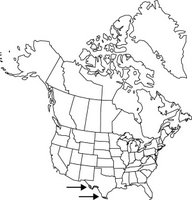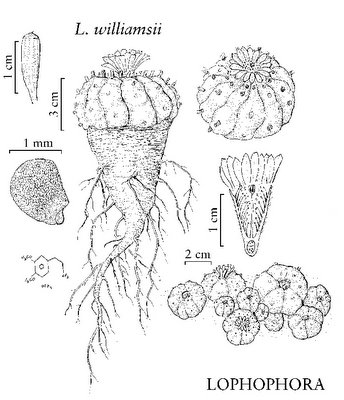J. M. Coulter, Contr. U.S. Natl. Herb. 3: 131. 1894.
Peyote [Greek lophos, crest, and phoreus, a bearer, in reference to tufts of hairs in areoles]
Allan D. Zimmerman & Bruce D. Parfitt
Plants erect, commonly unbranched, becoming many branched and moundlike in old age, deep-seated in substrate. Roots taproots. Stems unsegmented, usually gray-green or blue-green to dark green [yellow-green in L. diffusa of Mexico], usually flat-topped and cryptic in soil surface, sometimes protruding above it with recessed apex, ribbed or weakly tuberculate, 2-7.5 × (4-)5-12 cm, softly fleshy, soft skinned, dull, glabrous; ribs 5, 8, or 13 (rarely 21), low, broadly rounded, straight, vertical or less often helically curved around stem; areoles 3-15+ mm apart along ribs or at apices of low, humplike tubercles, circular, copiously hairy, hairs usually in compact, erect tufts to 7-10 mm; areolar glands absent; cortex and pith not mucilaginous. Spines absent. Flowers diurnal, deeply nestled in copious areolar hairs at stem apex, arising from adaxial edges of areoles, campanulate, 1-3 × (1-)1.5-2.5 cm; outer tepals whitish to greenish pink, midrib greenish, margins entire or minutely fringed or ciliate distally; inner tepals usually white to pink [rarely yellowish white or magenta to reddish violet, at least in Coahuila, Mexico], 8-14(-22) × (1-)2.5-5 mm, margins ciliate or entire; ovary smooth, scales, hairs, and spines absent; stigma lobes (3-)4-8, white or pinkish, 1-3 mm. Fruits indehiscent, white to pinkish [to purple], clavate to nearly cylindric, 11-25 × (2-)4-5 mm, weakly succulent, quickly drying and contracting after ripening, upon drying becoming translucent and brownish white or whitish, spines and scales absent; pulp colorless; floral remnant weakly persistent or tardily deciduous. Seeds black, somewhat pyriform, cylindric, or obovoid, 1-1.5 × 1-1.2 mm, not glossy, with large, flat hilum; testa cells strongly convex. x = 11.
Species 2 (1 in the flora): arid regions, sw United States, Mexico.
1. Lophophora williamsii (Lemaire ex Salm-Dyck) J. M. Coulter, Contr. U.S. Natl. Herb. 3: 131. 1894.
Mescal buttons, divine cactus
 Echinocactus williamsii Lemaire ex Salm-Dyck, Allg. Gartenzeitung 13: 385. 1845; Anhalonium williamsii (Lemaire ex Salm-Dyck) Lemaire
Echinocactus williamsii Lemaire ex Salm-Dyck, Allg. Gartenzeitung 13: 385. 1845; Anhalonium williamsii (Lemaire ex Salm-Dyck) Lemaire
Plants 0-50-branched, nearly flush with soil surface. Roots fleshy, broadly carrot-shaped, 6-12 cm. Stems flat or domelike with deeply depressed center; ribs to 25 mm broad. Flowers: outer tepals narrowly elliptic to oblanceolate, apex acute, mucronate; inner tepals elliptic, margins white to greenish pink, midstripes darker, apex mucronate or attenuate; ovary 3-4.5 mm; styles white, 5-14 mm. 2n = 22.
Flowering Mar-May(-Sep). Chihuahuan desert scrub, Tamaulipan thorn scrub, usually on or near limestone hills; 100-1500[-1900] m; Tex.; Mexico (Chihuahua, Coahuila, Nuevo León, San Luis Potosí, Tamaulipas, Zacatecas).
Long used for religious and medicinal purposes by native peoples, Lophophora williamsii is famous for its psychoactive alkaloids, primarily mescaline, which are concentrated in the small, photosynthetic, above-ground portion of the stem. Experienced peyoteros harvest only the top few millimeters of the stem, leaving the deeply recessed apical meristem, thus allowing regeneration. The plants live for many decades and grow very slowly. Anhalonium, a later name for Ariocarpus, has been applied to species of Lophophora, and was widely used in older pharmaceutical literature.
Fruits abruptly ripen up to one year (rarely longer) after flowering.

Back to online articles.
The Flora of North America web site.



















No comments:
Post a Comment